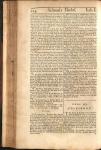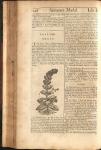

 I. The Names. It is called in Greek ******* from the similitude it has to a Crows foot: but the true Greek name is __ the Latins call it Cornu Cervi, or Cervinum, Coronopus Ruellij, Herba Stella, (both, from the form of the Leaves) Sanguinaria and Sanguinalis (from its stopping of Blood:) Harenaria, (from the Sandiness of the place it grows in:) and Nasturtium Verrucarium, (from the likeness of its Seeds to Warts:) And we in English call it, Bucks-horn, Swines Cresses, and Wart Cresses.
I. The Names. It is called in Greek ******* from the similitude it has to a Crows foot: but the true Greek name is __ the Latins call it Cornu Cervi, or Cervinum, Coronopus Ruellij, Herba Stella, (both, from the form of the Leaves) Sanguinaria and Sanguinalis (from its stopping of Blood:) Harenaria, (from the Sandiness of the place it grows in:) and Nasturtium Verrucarium, (from the likeness of its Seeds to Warts:) And we in English call it, Bucks-horn, Swines Cresses, and Wart Cresses.
II. The Kinds. It is twofold,
- 1. Coronopus recta Ruellij, Ambrosia Matthioli, Upright Bucks-horn, or Wart Cress. (Coronopus didymus. -Henriette.)
- 2. Coronopus repens Ruellij, Pseudocoronopus Dodonaei, Cornu Cervi alterum Vulgi; Creeping Bucks horn, or Wart Cress. (Coronopus squamatus. -Henriette.)
 III. The Description. The first has a small, long, white Root, with many Fibres thereat, running deep into the ground, the taste of which is somewhat like to the Garden Cress, but much milder. From this Root come forth several Branches; which grow up-right, but not very high; which Branches are also branched forth into others that are smaller: upon which grow very many small, long, and divided or cut green Leaves, all along on both sides of them, whose cuts very much resemble the snag's of a Bucks horn, or of some of the Leaves of the Garden Cress. The Flowers grow among the Leaves, coming forth With them at the Joints, they come forth in small rough Clusters, and are small and white, or of an herby greenish color, many of them set upon a small long Footstalk, one above another: which being past, there come in place, small, flatish, rough, round husks, something resembling rough or seeded Warts, which divide themselves into two parts, and contain in each of them a small brownish Seed.
III. The Description. The first has a small, long, white Root, with many Fibres thereat, running deep into the ground, the taste of which is somewhat like to the Garden Cress, but much milder. From this Root come forth several Branches; which grow up-right, but not very high; which Branches are also branched forth into others that are smaller: upon which grow very many small, long, and divided or cut green Leaves, all along on both sides of them, whose cuts very much resemble the snag's of a Bucks horn, or of some of the Leaves of the Garden Cress. The Flowers grow among the Leaves, coming forth With them at the Joints, they come forth in small rough Clusters, and are small and white, or of an herby greenish color, many of them set upon a small long Footstalk, one above another: which being past, there come in place, small, flatish, rough, round husks, something resembling rough or seeded Warts, which divide themselves into two parts, and contain in each of them a small brownish Seed.
IV. Ambrosia, or Coronopus repens, is altogether like the former, saving in the manner of its growing: It is a small low herb, most usually creeping with many long Branches, and spreading a great way, almost round about, upon the ground (yet in some places standing more upright: This Creeping kind never rises above four or five Inches high, but the trailing Branches are furnished with such like Leaves and Flowers as the former, which have a taste a little like Cresses. It is many times used to be eaten as a Sallet Herb, with Salt, Oil, and Vinegar, and that both raw and boiled.
V. The Places. They grow almost every where round about London, and in many other pares of the Kingdom in moist Grounds, and at the foot of Banks, where there is any low Trench, or places continually plashed with Water: sometimes by Highway sides, especially in those places where Hogs frequent, from whence, as is supposed, they were called Swines Cresses.
VI. The Times. They flower and seed all May, June, and July and their green Leaves abide fresh in a manner all Winter.
VII. The Qualities. They are hot and dry in the first Degree; astringent, Abstersive, Digestive, Carminative and Vulnerary; Cephalick, Stomatick, Pectoral, Hepatick, and Hysterick; Alterative, Alexipharmick, and Spermatogenetick.
VIII. The Specification. They are said to be peculiar for taking away Warts, for that the Seed bear the perfect signature of the Warts upon a Man's Hand.
IX. The Preparations. You may make therefrom,
- 1. A Liquid Juice.
- 2. An Essence.
- 3. A Decoction.
- 4. A Balsam or Ointment.
- 5. A Cataplasm.
The Virtues.
X. The Liquid Juice. Given to three or four ounces, it is Traumatick, or contributes to the more speedy cure of Wounds and Ulcers, more Specially in Scorbutick and Cachetick habits of Body: made thick with fine Bole, and applied, it stops bleeding.
XI. The Essence. It strengthens the Head, Stomach, Liver, Womb, and Joints, and is of singular good use against the Scurvy, Cachexia, and disaffections of the Womb. It represses Vapors, and is good against Fits of the Mother. It is also Traumatick, having all the Virtues of the Liquid Juice. Dose from one ounce to three, Morning and Evening, either by it self, or mixt with a Glass of Wine.
XII. The Decoction. If made in Wine, it is a good Stomatick, and Hepatick, has the Virtues of the Essence, but not all out so powerful: and externally applied to Wounds, it cleanses, dries, and contributes to their healing, and withal represses the flux of Humors into the part, hindering Pain and Inflammations.
XIII. The Balsam or Ointment. It is an excellent thing for healing of green Wounds, which it speedily performs: it also cleanses, incarnates, dries and heals old Ulcers, or running Sores, strengthens the parts afflicted, and makes them able to resist a flux of Humors falling upon them.
 XIV. The Cataplasm. Being applied it has (says Matthiolus) an adstringent and repelling power: and therefore must necessarily repercuss Humors, abate Inflammations, ease Pain, and strengthen the part, especially in the Gout, Sciatica, and other like Disaffections: Applied upon Warts, it cures them.
XIV. The Cataplasm. Being applied it has (says Matthiolus) an adstringent and repelling power: and therefore must necessarily repercuss Humors, abate Inflammations, ease Pain, and strengthen the part, especially in the Gout, Sciatica, and other like Disaffections: Applied upon Warts, it cures them.
Botanologia, or The English Herbal, was written by William Salmon, M.D., in 1710.
This chapter has been proofread by Nick Jones.

